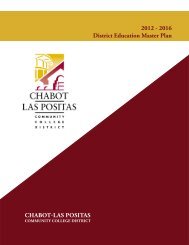City College of San Francisco - California Competes
City College of San Francisco - California Competes
City College of San Francisco - California Competes
Create successful ePaper yourself
Turn your PDF publications into a flip-book with our unique Google optimized e-Paper software.
STANDARD I<br />
III. Strengths & Areas for Improvement<br />
1. The <strong>College</strong> has done a commendable<br />
job developing a comprehensive planning,<br />
budgeting, and assessment process that<br />
establishes a direct relationship among the<br />
Mission and Vision statements, the Strategic<br />
Plan, and the annual planning and budgeting<br />
process. The <strong>College</strong> develops and revises<br />
these statements and plans through broadly<br />
inclusive, reflective dialogs among campus<br />
constituencies and representatives <strong>of</strong> the<br />
community. A biennial comprehensive<br />
assessment is undertaken <strong>of</strong> progress on<br />
the Annual Plan. However, the process for<br />
integrating the strategic planning initiatives<br />
into the Annual Plans and the evaluation<br />
<strong>of</strong> progress made each year on the Annual<br />
Plans should be more thoroughly integrated<br />
into the Shared Governance planning and<br />
budgeting procedures. Doing so would<br />
promote more reflective dialog among the<br />
campus constituencies, and that dialog is<br />
likely to lead to further improvements in<br />
student outcomes and institutional<br />
effectiveness.<br />
2. While the <strong>College</strong> has a systematic procedure<br />
for Program Review, and Program Review<br />
reports are generally completed according<br />
to the prescribed cycle, the results <strong>of</strong> Program<br />
Review are not integrated into the planning<br />
and budgeting process and the overall<br />
assessment <strong>of</strong> institutional effectiveness. The<br />
<strong>College</strong> should undertake a comprehensive<br />
assessment <strong>of</strong> the goals and objectives <strong>of</strong><br />
Program Review, the need to integrate<br />
Program Review into existing planning<br />
and evaluation procedures, and the role <strong>of</strong><br />
Program Review in the establishment and<br />
assessment <strong>of</strong> student learning outcomes.<br />
In addition, this review should determine<br />
the appropriate role and processes for<br />
Program Review for administrative units<br />
and establish procedures that ensure timely<br />
participation.<br />
3. The <strong>College</strong> has done an excellent job <strong>of</strong><br />
providing usable data related to demand for<br />
courses, student demographics, productivity<br />
analyses, and student persistence and success<br />
rates for all students in credit programs.<br />
The establishment <strong>of</strong> <strong>College</strong> Performance<br />
Indicators and the annual assessments <strong>of</strong><br />
progress on those indicators greatly enhance<br />
the <strong>College</strong>’s ability to provide evidence <strong>of</strong> its<br />
effectiveness to campus constituencies and to<br />
the communities that the <strong>College</strong> serves. In<br />
addition, the <strong>College</strong> has focused significant<br />
attention, research, and resources on the<br />
effectiveness <strong>of</strong> instruction and support<br />
services for basic skills in an effort to promote<br />
student success. Initiatives like the Enhanced<br />
Self-Study, the development <strong>of</strong> multiple<br />
targeted student retention programs, and the<br />
<strong>College</strong>’s aggressive and highly successful<br />
efforts to solicit external resources to support<br />
innovative program development all reflect<br />
the <strong>College</strong>’s active commitment to its Mission<br />
and Vision Statements.<br />
4. Since the last Self Study, the <strong>College</strong> has<br />
made impressive strides in communications<br />
with external constituencies, both in terms<br />
<strong>of</strong> reaching out to the community to inform<br />
the public about the <strong>College</strong>’s quality and<br />
activities, and listening to the community<br />
regarding what needs the <strong>College</strong> should and<br />
can address. Although there is always room<br />
for improvement in communicating with the<br />
public, the many ways in which the <strong>College</strong><br />
reaches out to the community is impressive,<br />
and continues to increase month by month.<br />
In addition, the <strong>College</strong> is making continual<br />
improvements in its internal communications.<br />
By rapidly expanding computer, email,<br />
voicemail and “voice over IP” access for<br />
employees at all campuses, the institution<br />
has created the infrastructure for significantly<br />
improved internal communication, promoting<br />
dialog, consensus, and innovations for<br />
learning across geographic boundaries.<br />
102 CITY COLLEGE OF SAN FRANCISCO







